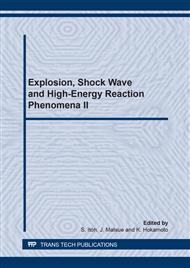p.53
p.61
p.65
p.71
p.77
p.83
p.89
p.95
p.101
Numerical Simulation of Underwater Explosive Compaction Process for Compaction of Tungsten Powder
Abstract:
Underwater explosive compaction is a modified explosive compaction process that is used for manufacturing of parts by compaction of hard powders such as tungsten powder. In the present research work, equation of state (EOS) for tungsten powder was determined by a theoretical method and numerical simulation of the underwater explosive compaction process for tungsten powder was done using LS-DYNA program. The simulation results were utilized for the optimization of die design setups, which were used in our experimental test. Several experiments for compaction of tungsten amorphous powder with a mean grain size about 5 microns were performed using C4 explosive with a detonation velocity about 8.2 km/s. The hardness and density of consolidated samples were determined. The fragmented surfaces of samples were analyzed by scanning electron microscope (SEM). The experimental results indicated the usefulness of computer simulation for optimization of die design and the process parameters. In addition, the results indicated that the tungsten parts without cracks and with a high relative hardness and density could be obtained by underwater explosive compaction method.
Info:
Periodical:
Pages:
77-82
Citation:
Online since:
November 2007
Authors:
Price:
Сopyright:
© 2008 Trans Tech Publications Ltd. All Rights Reserved
Share:
Citation:


